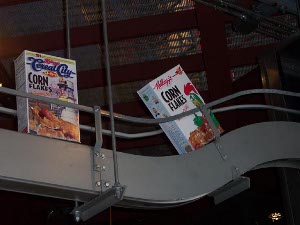 Hillsdale Administration
Art and went with them."
Hillsdale Administration
Art and went with them."
Elsa's father used to tell how he went to college: "I was sitting on my porch one day, after high school, and some friends came by and said they were on their way to Hillsdale College. They said the tuition was only $75.00 a year and even less if you would play baseball. So I got a loan from my brother  Hillsdale Administration
Art and went with them."
Hillsdale Administration
Art and went with them."
Today, almost eighty years later, Hillsdale College is still a small private liberal arts college in West-central Michigan, with a national reputation for sponsoring right-wing political philosophy -- in Roy Walther's day it was a small private Baptist college, struggling to stay afloat and without any political philosophy to speak of. The town of Hillsdale is like many other small Michigan towns in the area, with shops and cafes in 19th-century brick buildings and comfortable homes with tree-shaded lawns surrounding the small campus.
It was a foggy, drizzly morning, and the old administration building loomed through the mist, imposing with its steep steps and clock tower. Hospitable staff in the neighboring, newer administsration building produced copies of college yearbooks for the years in question -- 1922 to 1926. The young man who had headed off to college on a whim took to the college life with enthusiasm, participating in the Glee Club, the debate team and the weekly newspaper, where he became business manager. In his senior year he was one of four speakers at a banquet.
The skies were clearing by the time the yearbook examination had concluded, and Battle Creek beckoned. This is Cereal City and there's a cornflakes museum to prove it. The Seventh Day Adventists had established a Sanatarium there in 1866, to teach visitors how to live a healthy life. One by-product of  Corn flakes conveyor belt
the search for healthy grains which tasted good was Corn Flakes (the addition of malt and sugar made them more palatable than the plain wheat-berry concoctions produced previously). At its peak, Battle Creek was home to not only Kellogg but also Post and Ralston cereals -- the plants are still working, emitting steam which has a lightly sugared aroma.
Corn flakes conveyor belt
the search for healthy grains which tasted good was Corn Flakes (the addition of malt and sugar made them more palatable than the plain wheat-berry concoctions produced previously). At its peak, Battle Creek was home to not only Kellogg but also Post and Ralston cereals -- the plants are still working, emitting steam which has a lightly sugared aroma.
Cereal City is a kind of museum/souvenir shop/nostalgia trip sponsored by Kelloggs and some civic boosters. Visitors can see videos of old commercials and collections of early premiums (including some hand puppets we remember from our early childhood). There are educational displays of how cereals are produced, and a simulated production line. Snap, Crackle and Pop are major characters here, and Tony the Tiger wanders about in his orange suit.
It's not all cereal, however, in Battle Creek. The Seventh Day Adventists are working hard on Adventist Village, a collection of historic  Underground railroad memorial
structures which will tell the story of the denomination's history. The buildings are in place now, but not yet open for visits. At the same time the Sanitarium was prospering, the town was also a major stop on the Underground Railroad, apparently popular with fleeing slaves who wanted to get to Canada without having to cross Lake Erie. Local Quaker residents Erastus and Sarah Hussey assisted more than 1,000 fugitive slaves to freedom between 1840 and 1855. A recent statue in a local park illustrates the drama.
Underground railroad memorial
structures which will tell the story of the denomination's history. The buildings are in place now, but not yet open for visits. At the same time the Sanitarium was prospering, the town was also a major stop on the Underground Railroad, apparently popular with fleeing slaves who wanted to get to Canada without having to cross Lake Erie. Local Quaker residents Erastus and Sarah Hussey assisted more than 1,000 fugitive slaves to freedom between 1840 and 1855. A recent statue in a local park illustrates the drama.
Perhaps the most famous former slave to live in Battle Creek was Sojourner Truth, who spent the last twenty-six years of her life in the city and is buried in the local cemetery. Her monument includes a replica of the only known sample of her handwriting -- it was illegal to teach slaves to read and write, and by the time she walked away from her fourth and last owner she was too busy speaking and preaching to take time to learn.